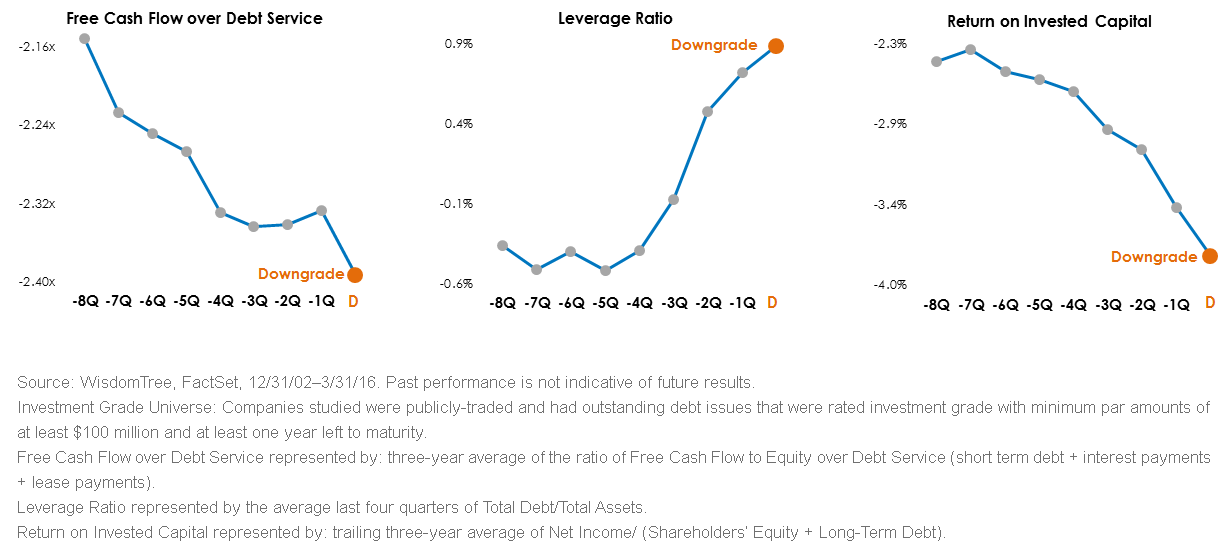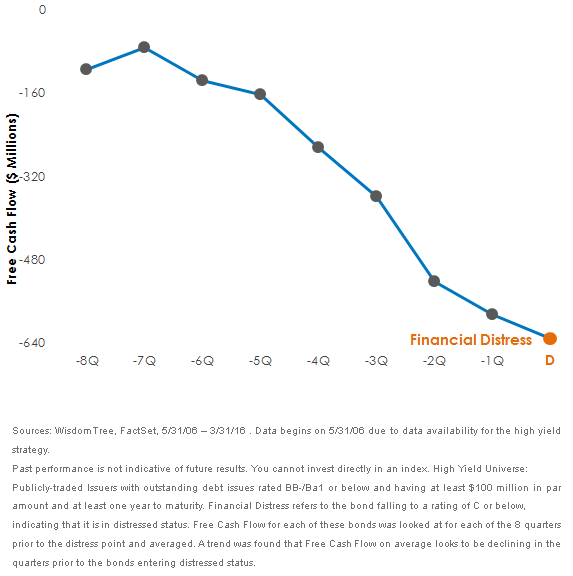U.S. Fixed Income: Get Smart … Beta


 For the high-yield (HY) universe, it is important to note that a large majority of companies in distressed situations tend to begin with cash flow problems. Against this backdrop, similar to the IG analysis, our work revealed that companies with sustained negative free cash flow often experienced an eventual downgrade (figure 2). It is important to keep in mind that within the HY sector there is less cushion on this front, and downgrades can lead to default concerns quickly.
Figure 2: High-Yield Corporates: Free Cash Flow Prior to Distress
For the high-yield (HY) universe, it is important to note that a large majority of companies in distressed situations tend to begin with cash flow problems. Against this backdrop, similar to the IG analysis, our work revealed that companies with sustained negative free cash flow often experienced an eventual downgrade (figure 2). It is important to keep in mind that within the HY sector there is less cushion on this front, and downgrades can lead to default concerns quickly.
Figure 2: High-Yield Corporates: Free Cash Flow Prior to Distress
 WisdomTree has been at the forefront of smart beta for some time, and we are now taking the next step forward for investors, and that is using this same approach for fixed income. Specifically, the fundamental, or smart beta, methodology follows a rules-based approach to fixed income investing with the emphasis being on fundamentals, not market cap. In this case, we utilize the above analysis, and for IG, cut the worst 20% from the defined universe. In HY, we eliminate all issuers with negative free cash flow and also remove the 5% with the lowest estimated liquidity.
WisdomTree fixed income fundamentally-based, or smart beta, products-The WisdomTree Fundamental U.S. Corporate Bond Fund (WFIG), the WisdomTree Fundamental U.S. Short-Term Corporate Bond Fund (SFIG), the WisdomTree Fundamental U.S. High Yield Corporate Bond Fund (WFHY) and the WisdomTree Fundamental U.S. Short-Term High Yield Corporate Bond Fund (SFHY) emphasize a qualitative approach, with a tilt toward income. With interest rates expected to remain in a range-bound pattern and credit concerns (downgrades and defaults) making headlines, fixed income investors will likely be searching for solutions that provide relative income opportunities in an environment in which increased credit quality is desired. With that in mind, we believe fixed income investors would benefit from a fundamental, rules-based approach to investing.
Conclusion
The WisdomTree fundamental fixed income Funds can be used as either a substitute or complement in a fixed income portfolio. They fit inside WisdomTree’s suite of fixed income products, potentially serving as the allocation to U.S.-based fixed income, specifically in the credit sector.
WisdomTree has been at the forefront of smart beta for some time, and we are now taking the next step forward for investors, and that is using this same approach for fixed income. Specifically, the fundamental, or smart beta, methodology follows a rules-based approach to fixed income investing with the emphasis being on fundamentals, not market cap. In this case, we utilize the above analysis, and for IG, cut the worst 20% from the defined universe. In HY, we eliminate all issuers with negative free cash flow and also remove the 5% with the lowest estimated liquidity.
WisdomTree fixed income fundamentally-based, or smart beta, products-The WisdomTree Fundamental U.S. Corporate Bond Fund (WFIG), the WisdomTree Fundamental U.S. Short-Term Corporate Bond Fund (SFIG), the WisdomTree Fundamental U.S. High Yield Corporate Bond Fund (WFHY) and the WisdomTree Fundamental U.S. Short-Term High Yield Corporate Bond Fund (SFHY) emphasize a qualitative approach, with a tilt toward income. With interest rates expected to remain in a range-bound pattern and credit concerns (downgrades and defaults) making headlines, fixed income investors will likely be searching for solutions that provide relative income opportunities in an environment in which increased credit quality is desired. With that in mind, we believe fixed income investors would benefit from a fundamental, rules-based approach to investing.
Conclusion
The WisdomTree fundamental fixed income Funds can be used as either a substitute or complement in a fixed income portfolio. They fit inside WisdomTree’s suite of fixed income products, potentially serving as the allocation to U.S.-based fixed income, specifically in the credit sector.
Important Risks Related to this Article
Fixed income investments are subject to interest rate risk; their value will normally decline as interest rates rise. Fixed income investments are also subject to credit risk, the risk that the issuer of a bond will fail to pay interest and principal in a timely manner or that negative perceptions of the issuer’s ability to make such payments will cause the price of that bond to decline.
High-yield or “junk” bonds have lower credit ratings and involve a greater risk to principal.
While the Funds attempt to limit credit and counterparty exposure, the value of an investment in the Funds may change quickly and without warning in response to issuer or counterparty defaults and changes in the credit ratings of each Fund’s portfolio investments. Please read each Fund’s prospectus for specific details regarding each Fund’s risk profile.


